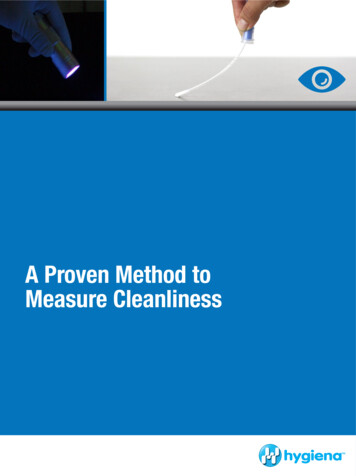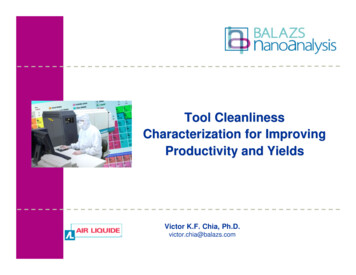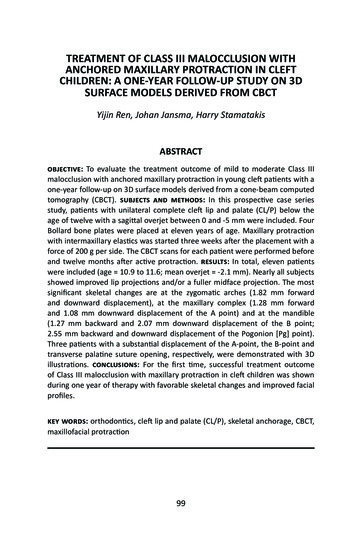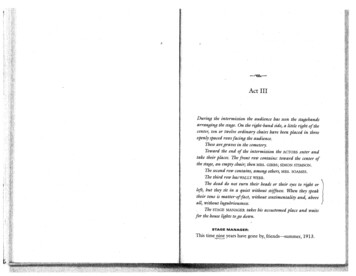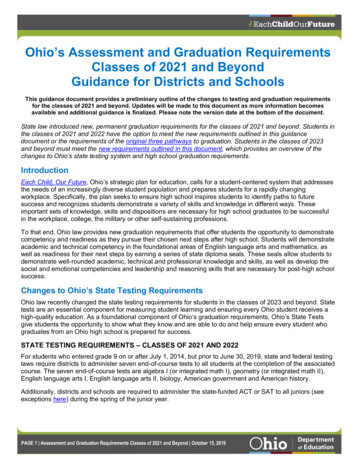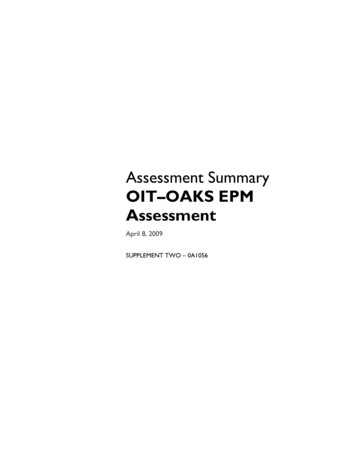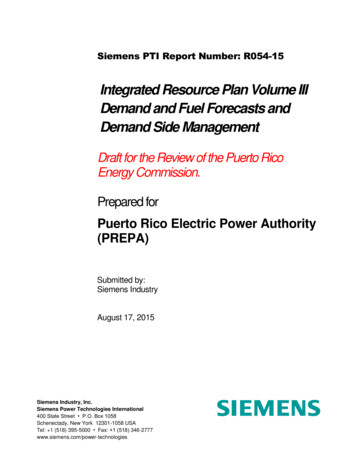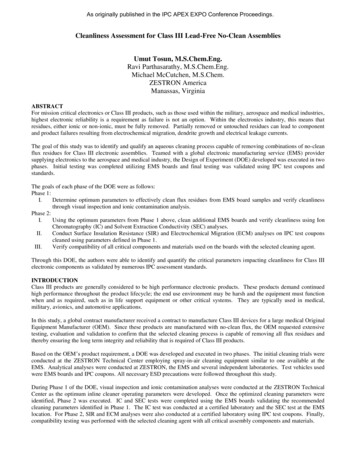
Transcription
As originally published in the IPC APEX EXPO Conference Proceedings.Cleanliness Assessment for Class III Lead-Free No-Clean AssembliesUmut Tosun, M.S.Chem.Eng.Ravi Parthasarathy, M.S.Chem.Eng.Michael McCutchen, M.S.Chem.ZESTRON AmericaManassas, VirginiaABSTRACTFor mission critical electronics or Class III products, such as those used within the military, aerospace and medical industries,highest electronic reliability is a requirement as failure is not an option. Within the electronics industry, this means thatresidues, either ionic or non-ionic, must be fully removed. Partially removed or untouched residues can lead to componentand product failures resulting from electrochemical migration, dendrite growth and electrical leakage currents.The goal of this study was to identify and qualify an aqueous cleaning process capable of removing combinations of no-cleanflux residues for Class III electronic assemblies. Teamed with a global electronic manufacturing service (EMS) providersupplying electronics to the aerospace and medical industry, the Design of Experiment (DOE) developed was executed in twophases. Initial testing was completed utilizing EMS boards and final testing was validated using IPC test coupons andstandards.The goals of each phase of the DOE were as follows:Phase 1:I.Determine optimum parameters to effectively clean flux residues from EMS board samples and verify cleanlinessthrough visual inspection and ionic contamination analysis.Phase 2:I.Using the optimum parameters from Phase 1 above, clean additional EMS boards and verify cleanliness using IonChromatography (IC) and Solvent Extraction Conductivity (SEC) analyses.II.Conduct Surface Insulation Resistance (SIR) and Electrochemical Migration (ECM) analyses on IPC test couponscleaned using parameters defined in Phase 1.III.Verify compatibility of all critical components and materials used on the boards with the selected cleaning agent.Through this DOE, the authors were able to identify and quantify the critical parameters impacting cleanliness for Class IIIelectronic components as validated by numerous IPC assessment standards.INTRODUCTIONClass III products are generally considered to be high performance electronic products. These products demand continuedhigh performance throughout the product lifecycle; the end use environment may be harsh and the equipment must functionwhen and as required, such as in life support equipment or other critical systems. They are typically used in medical,military, avionics, and automotive applications.In this study, a global contract manufacturer received a contract to manufacture Class III devices for a large medical OriginalEquipment Manufacturer (OEM). Since these products are manufactured with no-clean flux, the OEM requested extensivetesting, evaluation and validation to confirm that the selected cleaning process is capable of removing all flux residues andthereby ensuring the long term integrity and reliability that is required of Class III products.Based on the OEM’s product requirement, a DOE was developed and executed in two phases. The initial cleaning trials wereconducted at the ZESTRON Technical Center employing spray-in-air cleaning equipment similar to one available at theEMS. Analytical analyses were conducted at ZESTRON, the EMS and several independent laboratories. Test vehicles usedwere EMS boards and IPC coupons. All necessary ESD precautions were followed throughout this study.During Phase 1 of the DOE, visual inspection and ionic contamination analyses were conducted at the ZESTRON TechnicalCenter as the optimum inline cleaner operating parameters were developed. Once the optimized cleaning parameters wereidentified, Phase 2 was executed. IC and SEC tests were completed using the EMS boards validating the recommendedcleaning parameters identified in Phase 1. The IC test was conducted at a certified laboratory and the SEC test at the EMSlocation. For Phase 2, SIR and ECM analyses were also conducted at a certified laboratory using IPC test coupons. Finally,compatibility testing was performed with the selected cleaning agent with all critical assembly components and materials.
Following the successful execution of the DOE, the recommended cleaning process was implemented at the OEM site andthe cleaning results were validated.DISCUSSION OF METHODOLOGYThe EMS used six (three each) solder pastes and wave fluxes within their manufacturing process and cleans all PrintedCircuit Boards (PCBs) through an inline spray-in-air cleaner. Thus, for this study, the six solder pastes and liquid fluxes usedwere identified as Solder Paste A (leaded no-clean), Solder Paste B (lead-free no-clean), Solder Paste C (no-clean tacky flux)and Wave Flux D (no-clean leaded process), Wave Flux E (no-clean lead-free process) and Wave Flux F (no-clean lead-freeprocess).Upon considering wave flux process options within the DOE, the EMS requested for the cleaning process parameters, fordried flux (flux only) as well as activated flux (flux and solder) to be identified. Thus, it was decided to prepare boards withactivated flux, dried flux and a combination of activated and dried flux. Although cleaning parameters were optimized for allcombinations and verified using IC and SEC analyses, cleaning parameters for the activated and dried flux boards (labeled asActDry) were considered the most challenging and therefore used as the basis for recommending optimal inline cleaningparameters.Thus, wave solder fluxes were classified as: Activated flux (labeled as Act) Dried flux (labeled as Dry) Activated and dried flux (labeled as ActDry)Prior to executing Phase 1 of the DOE, an aqueous cleaning agent was selected on the basis of its ability to solubilize theselected pastes and fluxes as well as its compatibility with the application cleaning equipment. As a result of this analysis, amicro phase cleaning agent, identified as Cleaning Agent A, was selected for all the cleaning trials within this DOE.Phase 1: Test ProtocolThe EMS initially provided fifty-nine (59) test boards for use in the initial DOE. The boards were categorized by paste andflux type. Of these, thirty-two (32) boards were used to determine optimum wash settings for the inline cleaner, includingcleaning agent concentration, wash temperature and wash exposure time. Initial cleanliness assessments were made usingvisual inspection and ionic contamination analysis.Visual inspection was conducted according to IPC-A-610E [1]. Ionic contamination analysis was conducted using testequipment with a 75% solution IPA in DI-water in accordance with the IPC-TM-650 Method 2.3.25 [2]. This evaluation wasbased on J-STD-001E [3].The initial cleaning trials as well as the visual inspection and ionic contamination analyses were conducted at the ZESTRONTechnical Center since this location had the same cleaning equipment as the contract manufacturer site.Of the fifty-nine (59) boards provided by the EMS, they were categorized and processed as follows: Twenty-six (26) boards were reflowed using the three solder paste varieties and divided into three groups:o Seventeen (17) were used for defining inline process parameterso Six (6) were used for Ion Chromatography analysiso Three (3) were used for SEC analysis Thirty-three (33) boards were soldered with the three wave flux varieties and divided into three groups:o Fifteen (15) were used for defining inline process parameterso Twelve (12) used for Ion Chromatography analysiso Six (6) were used for SEC analysis
Table 1: Board Categorization by Paste and Flux typeNumber of Boards UsedPaste / Board #Paste A / 1-9Paste B / 1-9Paste C / 1-8Sub Total Paste:Flux / Board #Flux D / 1-6 (Act)Flux D / 1-3 (Dry)Flux D / 1-2 (ActDry)Flux E / 1-6 (Act)Flux E / 1-3 (Dry)Flux E / 1-2 (ActDry)Flux F / 1-6 (Act)Flux F / 1-3 (Dry)Flux F / 1-2 (ActDry)Sub Total Flux:Grand 95923232RESULTS DISCUSSIONPhase 1: Cleaning ProcessDuring the process development trials using the initial thirty-two (32) boards, the cleaning agent concentration, washtemperature and inline conveyor belt speed were varied and the results were recorded as summarized in Table 2.At the conclusion of each trial with each board type, visual inspection and ionic contamination analyses were performed toassess board cleanliness until the optimum inline cleaner operating parameters were identified.Table 2: Cleaning Process Initial ParametersCleaning Process: Initial ParametersCleaning Agent Concentration:10% to 15%Wash Temperature:125 F to 145 FConveyor Belt Speed:2.0 to 2.5 ft/minPhase I: Cleaning Process ResultsThe inline cleaner process parameters evaluated as well as the ionic contamination test results are detailed in Table 3 andTable 4. The operating parameters yielding the lowest ionic contamination value for each solder and flux type arehighlighted in each table. For this analysis, the ionic contamination threshold was set at 10.06 μg/inch2.
Test #12345678910111213141516Table 3: Cleaning Results of the Post-Reflow BoardsCleaningWashRinsePaste /Belt SpeedAgent ATemp.Temp.Board #(FPM)Conc. (%)( F)( F)Paste B / 8Paste A / 8Paste C / 4Paste A / 9Paste B / 9Paste A / 3Paste C / 5Paste B / 1Paste A / 4Paste C / 6Paste B / 2Paste A / 2Paste C / 7Paste B / 3Paste A / 1Paste C / 35 F135 F135 F135 F125 F125 F125 F125 F125 F125 F135 F135 F135 F135 F135 F135 onicValues(μg/inch2)140 F140 F140 F140 F140 F140 F140 F140 F140 F140 F140 F140 F140 F140 F140 F140 FSolder paste substrate pictures before and after cleaning: Figures 1 – 6Figure 1: Paste A Before CleaningFigure 3: Paste B Before CleaningFigure 2: Paste A After CleaningFigure 4: Paste B After 340.120.040.790.590.00
Figure 5: Paste C Before CleaningTest #1234567891011121314Figure 6: Paste C After CleaningTable 4: Cleaning Results of the Post Wave-Solder BoardsCleaningWashRinseBelt SpeedFlux / Board #Agent ATemp.Temp.(FPM)Conc. (%)( F)( F)Flux D / 2 (ActDry)15%135 F2.0140 FFlux E / 2 (ActDry)15%135 F2.0140 FFlux F / 2 (ActDry)15%135 F2.0140 FFlux D / 1 (ActDry)15%145 F2.0140 FFlux E / 1 (ActDry)15%145 F2.0140 FFlux F / 1 (ActDry)15%145 F2.0140 FFlux D / 6 (Act)15%135 F2.0140 FFlux E / 1 (Act)15%135 F2.0140 FFlux F / 3 (Act)15%135 F2.0140 FFlux E / 5 (Act)15%145 F2.0140 FFlux F / 2 (Act)15%145 F2.0140 FFlux D / 5 (Act)10%135 F2.0140 FFlux E / 6 (Act)10%135 F2.0140 FFlux F / 1 (Act)10%135 F2.0140 70.081.000.800.271.300.080.15Wave flux substrate pictures before and after cleaning: Figures 7 – 12Figure 7: Wave Flux D (ActDry) Before CleaningFigure 9: Wave Flux E (ActDry) Before CleaningFigure 8: Wave Flux D After CleaningFigure 10: Wave Flux E (ActDry) After Cleaning
Figure 11: Wave Flux F (ActDry) Before CleaningFigure 12: Wave Flux F (ActDry) After CleaningPhase 1: Cleaning Process Results SummaryThrough the process development phase of this study, the authors identified the optimum cleaning parameters required inorder to fully remove all post-soldered flux residues. However, since the EMC was seeking a single process conditioncapable of cleaning all flux residues, the authors used this test data as the basis for the optimum process recommendation.These optimized cleaning process parameters were then employed throughout the remainder of the DOE. These findings aredetailed in Table 5.Table 5: Optimum Inline Cleaning Process ParametersOptimum Inline Cleaning Process ParametersPost Reflow FluxCleaning Agent Concentration:15% (by volume)Wash Temperature:135 FBelt Speed:2.0 FPMPost Wave FluxCleaning Agent Concentration:15% (by volume)Wash Temperature:145 FBelt Speed:2.0 FPMOptimized Cleaning Process Parameters:Cleaning Agent Concentration:15% (by volume)Wash Temperature:140 FBelt Speed:2.0 FPMPhase 2: Test ProtocolTo further validate the cleanliness results of the parameters identified in Table 5, SIR and ECM analyses were performedusing IPC test coupons. Following these tests, compatibility testing with critical components and materials was alsoperformed using the selected cleaning agent.Regarding the SIR and ECM tests, eighteen (18) IPC B-24 and nine (9) IPC B-25A test coupons were sourced incorporatingthe matrix of paste and flux types required. Additionally, control coupons were included in order to confirm the accuracy ofthe tests. Excluding the control coupons, all were cleaned utilizing the optimized cleaning parameters identified in Table 5.Once cleaned, all of the boards were sent to an independent laboratory for analysis. The SIR tests were conducted per JSTD-004B [4] and IPC-TM-650, Method 2.6.3.7 [5]. The ECM tests were conducted per J-STD-004A [6] and IPC-TM-650,Method 2.6.14.1 [7].Regarding material compatibility, separate tests were conducted using the EMS label material as well as a variety of criticalcomponents. For label compatibility trials, two (2) label types were evaluated; one used exclusively in the lead-free processand the other in the leaded process. The labels were passed through the inline cleaner five (5) times using Cleaning Agent A(15% concentration) at 140 F and 2.0 ft/min. As part of these trials, the labels were examined for adhesive and ink removalafter each inline pass.Material compatibility testing included short-term and long-term tests. For the short-term test, critical components weresubjected to Cleaning Agent A at a concentration of 30% and 140 F for 15 minutes in a beaker placed on a hot plate with amagnetic stirrer. Upon inspection following the test, if the part was not compromised, the beaker test was extended to 24hours as part of the long-term compatibility testing.
In additional to the beaker tests, the critical components were also passed through the inline cleaner five (5) times with thecleaning agent concentration at 15% and 140 F yielding a total exposure time of 13 minutes. The parts were then inspectedfor dimensional and cosmetic changes. The components subjected to material compatibility testing are detailed in Table 6.Separate material compatibility tests were conducted using the EMC label material as well as a variety of criticalcomponents.ItemMaterial1Plastic component2Wire harness34Copper cablesWire harness5Plastic componentTable 6: Components for Compatibility TestingIDQuantityDescriptiono One part used for short-term andlong-term testingA1, A2, A33o Second part used for inline testingo Third part for reference purposeso Used for short-term and long-termB1testingC1o Used for inline testingD1o Used for inline testingo One part used for short-term andE1, E22long-term testingo Second part used for inline testingPhase 2: Ion Chromatography ResultsFor this test, eighteen (18) EMS boards as referenced in Table 1 were cleaned using the optimized parameters detailed inTable 5 and sent to an independent analytical laboratory for analysis.The boards were divided into three groups consisting of six (6) samples each. These were Activated Flux samples, DriedFlux samples and Solder Paste samples. Ion Chromatography testing was conducted per IPC-TM-650, Method 2.3.28A [8].All results are detailed in Tables 7, 8 and 9.Based on the authors’ experience with this test methodology, the maximum contamination level for all ionic species isindicated within each table. As can be seen, the contamination level determined in all tests was found to be well below theacceptable limit.
Table 7: Ion Chromatography Results – Solder Paste SamplesAnions & WOA (Weak Organic NDND0.500.98Total WOA: 252.11Ionic SpeciesSolder Paste Type / Board NumberPastePastePastePasteA/6B/5B/6C/1(µg/in2) (µg/in2) (µg/in2) ContaminationLevel(µg/in2)Solder Paste Type / Board NumberPastePastePastePasteA/6B/5B/6C/1(µg/in2) (µg/in2) (µg/in2) m1NDNDNDNDNDNDCalciumND None Detected10.410.380.300.290.220.18Ionic SpeciesPasteC/2(µg/in2)ND
Table 8: Ion Chromatography Results – Activated Flux SamplesAnions & WOA (Weak Organic Acids)MaximumContaminationLevel �g/in2)0.160.16ND0.15NDNDND0.320.67Total WOA: 251.53Ionic SpeciesFlux Type / Board Act)(µg/in2) (µg/in2) (µg/in2) CationsIonic iumND None ux D /1 (Act)(µg/in2)ND1.511.581.050.090.2Flux Type / Board NumberFlux D / Flux E / Flux E / Flux F /2 (Act)2 (Act)3 (Act)4 (Act)(µg/in2) (µg/in2) (µg/in2) 881.170.771.370.040.030.030.06NDND0.070.13Flux F /5 (Act)(µg/in2)ND1.041.311.460.050.09
Table 9: Ion Chromatography Results – Dried Flux SamplesAnions & WOA (Weak Organic Acids)Ionic ePhosphateAcetateFormateTotal ux D /1 (Dry)(µg/in2)0.210.21ND0.040.050.32ND0.420.89 252.86Flux Type / Board NumberFlux D / Flux E / Flux E / Flux F /2 (Dry) 1 (Dry) 2 (Dry) 1 (Dry)(µg/in2) (µg/in2) (µg/in2) .36Flux F /2 CationsIonic iumND None ux D /1 (Dry)(µg/in2)ND1.21.361.140.090.36Flux Type / Board NumberFlux D / Flux E / Flux E / Flux F /2 (Dry) 1( Dry) 2 (Dry) 1 (Dry)(µg/in2) (µg/in2) (µg/in2) x F /2 (Dry)(µg/in2)ND0.991.151.680.070.22Phase 2: SEC ResultsFor this test, nine (9) EMC boards as referenced in Table 1 were cleaned using the optimized parameters detailed in Table 5and returned to the EMC for SEC analysis as per J-STD-001E [3]. SEC test results are detailed in Table 10.Paste / FluxPaste APaste BPaste CFlux D (Act)Flux E (Act)Flux F (Act)Flux D (Dry)Flux E (Dry)Flux F (Dry)Table 10: SEC 0260.0620.0230.0130.02All of the values obtained from the SEC tests as well as Ion Chromatography were well below the specifications set forth bythe EMS.
Phase 2: SIR and ECM ResultsFor all wave flux types, the SIR and ECM tests were conducted on both the Act and Dry test coupons only. With regard tothe SIR analysis (7 day, 85 C/85% RH), all test coupons met the minimum requirement ( 10 8). With regard to the ECManalysis (500 hours, 65 C, 85% RH), all test coupons met the minimum requirement (Final Initial/10).SIR test results for all pastes and wave fluxes: Figures 13 – 21Figure 13: Paste AFigure 14: Paste BFigure 15: Paste CFigure 16: Wave Flux D – ActivatedFigure 17: Wave Flux D – DriedFigure 18: Wave Flux E – ActivatedFigure 19: Wave Flux E – DriedFigure 20: Wave Flux F – Activated
Figure 21: Wave Flux F – DriedECM test results for all pastes and wave fluxes: Figures 22 – 30Figure 22: Paste AMinimum Requirement: 2.75E 09 (Pass)Figure 23: Paste BMinimum Requirement: 1.88E 09 (Pass)Figure 24: Paste
based on J-STD-001E [3]. The initial cleaning trials as well as the visual inspection and ionic contamination analyses were conducted at the ZESTRON Technical Center since this location had the same cleaning equipment as the contract manufacturer site. Of the fifty-nine (59) boards provid

